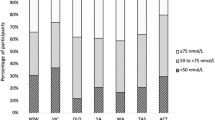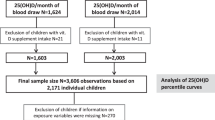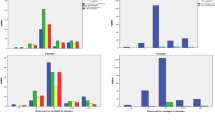Abstract
Background/objectives:
To study the relationship of winter 25-hydroxycholecalciferol (25-OHD) levels with age, education, place of residency, marital status and body mass index (BMI) as they may affect sun exposure, vitamin D synthesis and metabolism.
Subjects/methods:
Subjects (1952) answered a structured questionnaire concerning education, marital status and smoking; and body weight/height, and parathyroid hormone and 25-OHD were measured.
Results:
25-OHD levels were higher in the males with elementary and secondary education compared with higher education (46.8±18.5 and 43.7±16 vs 39.9±15.3 nmol/l, P<0.01). Vitamin D deficiency was more prevalent (16.7%, (13.1–20.2) vs 10.8%, (8.4–13.2), P=0.08) and sufficiency was less prevalent (24.6% (20–29.2) vs 33.7%, (29.5–37.8), P=0.005) in those with higher than secondary education. No differences were found among the females. Male smokers had lower 25-OHD than nonsmokers (40.2±16.6 vs 43.6±15.7 nmol/l, P=0.004). Deficiency was more prevalent in the male smokers than nonsmokers with secondary and higher education (secondary 16.6%, (10.1–22.4) vs 8.2%, (5.1–11.3), P=0.006; higher 27.4%, (17.7–37.1) vs 13.2%, (9.0–17.5), P=0.003). 25-OHD was lower in the obese than in the normal-weight females (34.6±16.2 vs 38.2±17.8 nmol/l, analysis of variance, P=0.014), but not males. Marital status was not related to 25-OHD. Only in the urban residents, increasing BMI in the young females increased the risk for vitamin D deficiency by 1%, and smoking had an odds ratio of 1.99 (1.05–3.78) in the young and 2.5 (1.07–5.75) in the middle-aged males.
Conclusions:
Smoking and higher education in the males and obesity in the females were factors for vitamin D deficiency among Bulgarian urban population.
This is a preview of subscription content, access via your institution
Access options
Subscribe to this journal
Receive 12 print issues and online access
$259.00 per year
only $21.58 per issue
Buy this article
- Purchase on Springer Link
- Instant access to full article PDF
Prices may be subject to local taxes which are calculated during checkout

Similar content being viewed by others
References
Van Schoor NM, Lips P . Worldwide vitamin D status. Best Pract Res Clin Endocrinol Metab 2011; 25: 671–680.
Semba RD, Houston DK, Bandinelli S, Sun K, Cherubini A, Cappola AR et al. Relationship of 25-hydroxyvitamin D with all-cause and cardiovascular disease mortality in older community-dwelling adults. Eur J Clin Nutr 2010; 64: 203–209.
Schierbeck LL, Rejnmark L, Tofteng CL, Stilgren L, Eiken P, Mosekilde L et al. Vitamin D deficiency in postmenopausal, healthy women predicts increased cardiovascular events: a 16-year follow-up study. Eur J Endocrinol 2012; 167: 553–560.
Welsh J . Vitamin D and cancer: integration of cellular biology, molecular mechanisms and animal models. Scand J Clin Lab Invest Suppl 2012; 243: 103–111.
Hewison M . Vitamin D and immune function: autocrine, paracrine or endocrine? Scand J Clin Lab Invest Suppl 2012; 243: 92–102.
Bogh MKB . Vitamin D production after UVB: aspects of UV-related and personal factors. Scand J Clin Lab Invest Suppl 2012; 243: 24–31.
Tsiaras WG, Weinstock MA . Factors influencing vitamin D status. Acta Derm Venereol 2011; 91: 115–124.
Chan J, Jaceldo-Siegl K, Fraser GE . Determinants of serum 25 hydroxyvitamin D levels in a nationwide cohort of blacks and non-Hispanic whites. Cancer Causes Control 2010; 21: 501–511.
Grant WB . Role of solar UV irradiance and smoking in cancer as inferred from cancer incidence rates by occupation in Nordic countries. Dermatoendocrinol 2012; 4: 203–211.
Borissova AM, Shinkov A, Vlahov J, Dakovska L, Todorov T, Svinarov D et al. Vitamin D status in Bulgaria—winter data. Arch Osteoporos 2013; 8: 133–138.
Bischoff-Ferrari H a. ‘Vitamin D - why does it matter?’ - defining vitamin D deficiency and its prevalence. Scand J Clin Lab Invest Suppl 2012; 243: 3–6.
Ross a C, Manson JE, Abrams S a, Aloia JF, Brannon PM, Clinton SK et al. The 2011 report on dietary reference intakes for calcium and vitamin D from the Institute of Medicine: what clinicians need to know. J Clin Endocrinol Metab 2011; 96: 53–58.
Borissova A-M, Shinkov A, Vlahov J, Dakovska L, Todorov T, Svinarov D et al. Determination of the optimal level of 25(OH)D in the Bulgarian population. Endokrinologya 2012; 17: 135–142.
FDA. Guidance for Industry Bioanalytical Method Validation. Rockville2001.
Souberbielle JC, Courbebaisse M, Cormier C, Pierrot-Deseilligny C, Viard JP, Jean G et al. When should we measure vitamin D concentration in clinical practice? Scand J Clin Lab Invest Suppl 2012; 243: 129–135.
Holick MF, Binkley NC, Bischoff-Ferrari HA, Gordon CM, Hanley DA, Heaney RP et al. Evaluation, treatment, and prevention of vitamin D deficiency: an Endocrine Society Clinical Practice Guideline. J Clin Endocrinol Metab 2011; 96: 1911–1930.
Pludowski P, Karczmarewicz E, Bayer M, Carter G, Chlebna-Sokół D, Czech-Kowalska J et al. Practical guidelines for the supplementation of vitamin D and the treatment of deficits in Central Europe - recommended vitamin D intakes in the general population and groups at risk of vitamin D deficiency. Endokrynol Pol 2013; 64: 319–327.
Larose TL, Chen Y, Camargo CA, Langhammer A, Romundstad P, Mai XM . Factors associated with vitamin D deficiency in a Norwegian population: the HUNT Study. J Epidemiol Community Health 2014; 68: 165–170.
Hadjinikolova L, Hubenova T, Zaikov A . Status and development tendencies of freshwater aquaculture production in Bulgaria. Bulg J Agric Sci 2010; 16: 398–405.
Park S, Lee BK . Vitamin D deficiency is an independent risk factor for cardiovascular disease in Koreans aged ≥50 years: results from the Korean National Health and Nutrition Examination Survey. Nutr Res Pract 2012; 6: 162–168.
Looker AC, Pfeiffer CM, Lacher DA, Schleicher RL, Picciano MF . Serum 25-hydroxyvitamin D status of the US population : 1988–1994 compared with 2000–2004 1–3. Am J Clin Nutr 2008; 88: 1519–1527.
Daly R, Gagnon C, Lu Z, Magliano D, Dunstan D, Sikaris K et al. Prevalence of vitamin D deficiency and its determinants in Australian adults aged 25 years and older: a national, population-based study. Clin Endocrinol (Oxf) 2012; 77: 26–35.
Genzen JR, Gosselin JT, Wilson TC, Racila E, Krasowski MD . Analysis of vitamin D status at two academic medical centers and a national reference laboratory: result patterns vary by age, gender, season, and patient location. BMC Endocr Disord 2013; 13: 52.
Greene-Finestone LS, Berger C, de Groh M, Hanley DA, Hidiroglou N, Sarafin K et al. 25-Hydroxyvitamin D in Canadian adults: biological, environmental, and behavioral correlates. Osteoporos Int 2011; 22: 1389–1399.
McCullough ML, Weinstein SJ, Freedman DM, Helzlsouer K, Flanders WD, Koenig K et al. Correlates of circulating 25-hydroxyvitamin D: Cohort Consortium Vitamin D Pooling Project of Rarer Cancers. Am J Epidemiol 2010; 172: 21–35.
Hypponen E, Power C . Hypovitaminosis D in British adults at age 45 y: nationwide cohort study of dietary and lifestyle predictors. Am J Clin Nutr 2007; 85: 860–868.
Shirazi L, Almquist M, Malm J, Wirfält E, Manjer J . Determinants of serum levels of vitamin D: a study of life-style, menopausal status, dietary intake, serum calcium, and PTH. BMC Womens Health 2013; 13: 33.
Tepper S, Shahar DR, Geva D, Ish-Shalom S . Predictors of serum 25(Oh)D increase following bimonthly supplementation with 100,000IU vitamin D in healthy, men aged 25-65 years. J Steroid Biochem Mol Biol 2013; e-pub ahead of print 12 December 2013; doi:10.1016/j.jsbmb.2013.12.005.
Drincic AT, Armas L a G, Van Diest EE, Heaney RP . Volumetric dilution, rather than sequestration best explains the low vitamin D status of obesity. Obesity (Silver Spring) 2012; 20: 1444–1448.
Kull M, Kallikorm R, Lember M . Body mass index determines sunbathing habits: implications on vitamin D levels. Intern Med J 2009; 39: 256–258.
Metheniti D, Sakka S, Dracopoulou M, Margeli A, Papassotiriou I, Kanaka-Gantenbein C et al. Decreased circulating 25-(OH) vitamin D concentrations in obese female children and adolescents: positive associations with retinol binding protein-4 and neutrophil gelatinase-associated lipocalin. Hormones (Athens) 2013; 12: 397–404.
González-Molero I, Rojo-Martínez G, Morcillo S, Gutierrez C, Rubio E, Pérez-Valero V et al. Hypovitaminosis D and incidence of obesity: a prospective study. Eur J Clin Nutr 2013; 67: 680–682.
Barchetta I, De Bernardinis M, Capoccia D, Baroni MG, Fontana M, Fraioli A et al. Hypovitaminosis D is independently associated with metabolic syndrome in obese patients. PLoS One 2013; 8: e68689.
Earthman CP, Beckman LM, Masodkar K, Sibley SD . The link between obesity and low circulating 25-hydroxyvitamin D concentrations: considerations and implications. Int J Obes 2012; 36: 387–396.
Wamberg L, Christiansen T, Paulsen SK, Fisker S, Rask P, Rejnmark L et al. Expression of vitamin D-metabolizing enzymes in human adipose tissue-the effect of obesity and diet-induced weight loss. Int J Obes 2013; 37: 651–657.
Wong KE, Kong J, Zhang W, Szeto FL, Ye H, Deb DK et al. Targeted expression of human vitamin D receptor in adipocytes decreases energy expenditure and induces obesity in mice. J Biol Chem 2011; 286: 33804–33810.
Soldin OP, Makambi KH, Soldin SJ, O’Mara DM . Steroid hormone levels associated with passive and active smoking. Steroids 2011; 76: 653–659.
Szulc P, Garnero P, Claustrat B, Marchand F, Duboeuf F, Delmas PD . Increased bone resorption in moderate smokers with low body weight: The Minos Study. J Clin Endocrinol Metab. Endocri Soc 2002; 87: 666–674.
Supervía A, Nogués X, Enjuanes A, Vila J, Mellibovsky L, Serrano S et al. Effect of smoking and smoking cessation on bone mass, bone remodeling, vitamin D, PTH and sex hormones. J Musculoskelet Neuronal Interact 2006; 6: 234–241.
Borissova A-M, Shinkov A, Vlahov J, Dakovska L, Todorov T, Svinarov D et al. Comparative analisis on distribution of deficiency and insufficiency of vitamin D in diferent types living places in Bulgaria. Endokrinologya 2013; 17: 143–157.
Acknowledgements
The study has been supported by the Bulgarian Society of Endocrinology to the best knowledge of the authors.
Author information
Authors and Affiliations
Corresponding author
Ethics declarations
Competing interests
The authors declare no conflict of interest.
Rights and permissions
About this article
Cite this article
Shinkov, A., Borissova, AM., Dakovska, L. et al. Winter 25-hydroxyvitamin D levels in young urban adults are affected by smoking, body mass index and educational level. Eur J Clin Nutr 69, 355–360 (2015). https://doi.org/10.1038/ejcn.2014.163
Received:
Revised:
Accepted:
Published:
Issue Date:
DOI: https://doi.org/10.1038/ejcn.2014.163
This article is cited by
-
Associations between ambient air pollution, obesity, and serum vitamin D status in the general population of Korean adults
BMC Public Health (2022)
-
Genetic influence on serum 25-hydroxyvitamin D concentration in Korean men: a cross-sectional study
Genes & Nutrition (2018)
-
Determinants of vitamin D status in young adults: influence of lifestyle, sociodemographic and anthropometric factors
BMC Public Health (2016)



